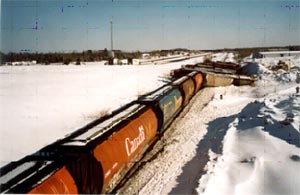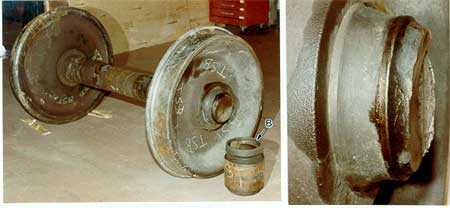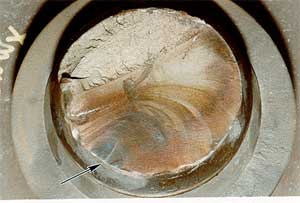Main track derailment
Canadian National
Train No G-894-31-14
Mile 12.56, Drummondville Subdivision
Trudel, Quebec
The Transportation Safety Board of Canada (TSB) investigated this occurrence for the purpose of advancing transportation safety. It is not the function of the Board to assign fault or determine civil or criminal liability. This report is not created for use in the context of legal, disciplinary or other proceedings. See Ownership and use of content. Masculine pronouns and position titles may be used to signify all genders to comply with the Canadian Transportation Accident Investigation and Safety Board Act (S.C. 1989, c. 3).
Summary
At 0820 eastern standard time on 15 February 2001, Canadian National train No G-894-31-14, proceeding eastward towards Québec, Quebec, derailed 25 cars at Mile 12.56 of the Drummondville Subdivision, near Trudel, Quebec. Twenty-four cars were destroyed, and one car sustained light damage. A main-track switch, the signal system, 800 metres of track, and goods stored on the property of a construction material distributor were damaged. No dangerous goods were involved and there were no injuries.
Ce rapport est également disponible en français.
Factual information
On 15 February 2001, the train left Turcot, Quebec with 3 locomotives and 93 covered hopper cars loaded with wheat. It was 6043 feet long and weighed 12 158 tons. The crew consisted of a conductor, a locomotive engineer and a locomotive engineer pilot. All crew members were familiar with the route, qualified for their positions and met established fitness and rest standards.
The train proceeded en route to Québec without incident until the train experienced a train-initiated emergency brake application at the M-211 industrial branch turnout, located under the Highway 171 overpass, which passes over the railway and Highway 20. Crew members followed emergency procedures and determined that 25 cars (57th to 81st) were derailed. The event recorder on the lead locomotive indicated that, at the time of the emergency brake application, the train was travelling at 51.8 mph with the throttle in notch 5.
According to the safety inspection log, certified personnel conducted a safety check of the train during marshalling at the Symington rail yard, in Winnipeg, Manitoba. En route, the train passed by several wayside inspection systems (WIS)Footnote 1, the last one located at mile 22.2 of the Drummondville Subdivision. In addition, pull-by inspectionsFootnote 2 conducted by other crews showed no anomalies. A pull-by inspection on the south side of the train conducted by a Canadian National (CN) foreman on the west end of the by-pass track at Trudel (Mile 13.8) also revealed no anomalies. According to the foreman, visibility was reduced by fresh snow that had fallen on the previous day, which was blown into the air as the train passed.
The Drummondville Subdivision extends 120 miles from Saint-Romuald, Quebec, to Sainte-Rosalie, Quebec. Train movements are governed by the Centralized Traffic Control System (CTC), in accordance with the Canadian Rail Operating Rules (CROR), under the supervision of a rail traffic controller stationed in Montréal, Quebec. The subdivision is a single east-west main track. In the derailment area, the maximum authorized speed is 90 mph for passenger trains and 60 mph for freight trains. On a daily basis, approximately 6 VIA Rail Canada trains and 20 freight trains travel over this subdivision.
Between Mile 12.10 and Mile 15.80, the track is straight, with a descending grade to the east. The track is composed of 132-pound continuous welded rail laid on double-shouldered tie plates and hardwood ties. The tie plates were fastened with four spikes per plate and box-anchored every tie. The ties were in good condition. The granite ballast was approximately 1 to 1.5 inches in diameter and 18 inches deep; the ballast shoulders ranged from 18 to 24 inches wide.
Track inspection frequency complied with regulations currently in force. No defects were noted in the derailment area during the most recent visual inspections, or during inspections conducted by a track recording car and a rail test car. Safety checks and assessments were conducted by Transport Canada (TC) two weeks before the derailment; no defects were observed.
The 57th car remained upright, 788 metres east of the main derailment area; its trailing truck derailed on the south side of the main track. The 23 cars that followed derailed in an accordion pattern (see Photo 1) over a distance of 64 metres, directly east of the M-211 turnout, on property belonging to a construction materials business adjacent to the right-of-way. The last derailed car remained upright, with its truck derailed on the south side of the track. The signal bungalow, located east of the M-211 turnout, as well as a communications tower belonging to CN, were destroyed. The underground fibre-optic cable was severed.
An examination of the track to the west of the M-211 turnout (Mile 12.65) revealed the presence of intermittent impact signs on the running surface of the south rail, as well as on the ties, spikes and tie plates on the south side of the track. There were wheel flange marks on the south switch of the M-211 turnout, one foot from the switch rail, and on the north rail, 15 feet from the switch rail. The north switch was bent and the spreader at the heel of the switch point was broken. The impact broke the south rail of the turnout, 13 metres from the switch; the frog was also damaged.
A section of a broken axle journal, with its roller bearing (see Photo 2), was found in the ditch on the south side of the track, at Mile 16.25; it originated from car CNWX 107921, the second derailed car. The car in question was a covered hopper car made of aluminum, with a light weight of 41 000 lb (20 045 kg) and maximum loaded weight of 220 000 lb (100 000 kg). The car's shipping record indicated that it was at its maximum load weight at the time of the derailment.
The sections of axle were sent to the Transportation Safety Board of Canada (TSB) Engineering Laboratory for analysis. An examination (Report No LP 11/01) revealed the presence of a fatigue fracture covering over 65 percent of the fracture surface (see Photo 3). This fracture was first found in numerous crack initiation sites in the axle journal fillet and in the journal box dust guard (axle journal fillet), and coincided with corrosion pitting. The fracture surfaces were highly oxidized, but there were no signs of overheating on any of the components. According to the TSB database, 7 axle fractures occurred in Canada in similar circumstances to this accident between 1998 and 2000 (corrosion pitting which led to fatigue cracking and ultimately to axle failure).Footnote 3
The lining used to protect the axle journal fillet area had lost some of its flexibility and had completely dried out; the lining used was an asphalt-based anti-oxidation coating approved by the Association of American Railroads (AAR), a lining currently used on axles. The bearing ring, the cones and the axle roller bearings showed signs of spalling on the fracture surface.
The axle was manufactured by Standard Steel Castings in March 1964, and was reshaped by GE Railcar in 1991. CN maintenance records indicate that new wheels, with 6 inch x 11 inch AP roller bearings, were installed on the axle in February 1994 at the Transcona shop in Winnipeg. The axle was installed at the "A" end of the car (fourth axle from "B" end) on 28 March 1994. All work was performed in compliance with AAR standards.
TC's Railway Freight Car Inspection and Safety Rules set out minimum safety standards for freight cars. The section concerning axle inspection and safety reads as follows:
A railway company may not place or continue a car in service if:
- an axle has a crack or is bent or broken;
- a journal shows evidence of overheating;
- a plain bearing axle has:
- a cracked or broken end collar; or
- a groove, pitting, rusting or etching on the surface of the journal; or
- an axle is the wrong size.
Standards and recommended practices that govern axle design, production and maintenance are included in the AAR Manual of Standards and Recommended Practices, Section G, (AAR Manual). Specifically, Rule 1A8 of the AAR Manual states that wheel seats and journal portions of unmounted secondhand axles in freight car service must be magnetic particle tested by the wet method. This procedure is not specifically required for the axle journal fillet, which only requires a visual inspection and removal of corrosion pitting, if necessary. However, in the last several years, certain certified shops and major Canadian railways, including CN, have gone above and beyond AAR requirements and extended magnetic particle testing to the axle journal fillet. The investigation did not reveal whether this practice was being followed when the axle in question was mounted at the Transcona shop in 1994.
According to Rule 1K8 of the AAR Manual, wheel shops must apply a uniform coating of an approved rust preventive material to the journal fillet portion prior to mounting a bearing on the axle. The coating prevents moisture from building on the journal; it must adhere to the surface and remain flexible.
While castor oil is used as a lubricant to facilitate the mounting of the wheels on the axle, its presence is undesirable. It absorbs water and may form a damp film that remains trapped under the coating and could result in premature oxidation of the axle. In addition, the oil may affect the adherence of the coating. Consequently, eliminating the oil from the surface of the axle is crucial to the coating's performance.
Following the wheel installation on the truck, the surface of the axle journal fillet is concealed by the roller bearing backing ring and is therefore no longer visible during safety inspections by certified staff.
Analysis
The fracture of the axle probably took place at the point where the end of the broken axle journal was found, at approximately Mile 16.25. Since it was not attached to the truck side frame, the end of the axle journal broke free at the time of the fracture, detached from the car and fell into the ditch. Since it no longer had any support, the side frame slumped onto the rail surface. The truck was then dragged along the rail surface until it reached switch M-211, causing the derailment of the other cars.
According to the results of the analysis conducted by the TSB Engineering Laboratory, the axle broke as a result of a fatigue fracture that originated in the axle journal fillet and that coincided with corrosion pitting. Since the axle fillet area is subjected to high stresses, and corrosion pitting acts as stress raisers, the number of loading cycles that the axle could withstand was decreased, leading to the initiation and development of fatigue fractures, and consequently, the failure of the axle.
Corrosion pitting on the axle journal fillets, as well as spalling on the bearing ring, cones and axle roller bearings, indicate that moisture penetrated and accumulated in the area. This moisture could have been the result of condensation that forms while the bearings cool down, but it could also have penetrated through the protective coating, which had completely dried out and become susceptible to moisture. For this reason, quality control during the application of the coating is essential to ensure protection against corrosion pitting.
The AAR does not specifically require that magnetic particle testing be used to check axle journal fillets; it only requires a visual inspection and the elimination of corrosion pitting, if necessary. This procedure may be insufficient in certain cases, since sub-surface fractures that originate in the corrosion pitting can remain even after the pitting has been eliminated. Major Canadian railroads and certain qualified shops have extended magnetic particle testing to cover the axle journal fillet. However, this practice has not been adopted by the entire industry, since it is not required by the AAR. In addition, TC's Railway Freight Car Inspection and Safety Rules do not contain any clauses pertaining to testing for internal defects. Consequently, axles with sub-surface fractures could be put in service.
Since these fractures cannot be detected during safety inspections, given that the axle journal fillet area is covered by the roller bearing backing ring, it is essential that a check be made for possible internal defects in the axle journal fillet in order to identify sub-surface fractures and reduce associated risk of axle failures.
The axle fatigue cracks could not be detected by the hot box detector, since they were not caused by excessive heating. Furthermore, the truck side frame dropped onto the track and was dragged approximately four miles before the accident site. Therefore it could not be detected by the dragging equipment detector, which is much further away. A pull-by inspection was conducted at the Trudel siding, however, the car's condition was not detected due to the poor visibility caused by blowing snow as the train passed by.
Findings
Findings as to causes and contributing factors
- The train derailed as a result of a fatigue fracture in an axle on car CNWX 107921.
- Penetration and accumulation of moisture created corrosion pitting, which led to the initiation and development of fatigue fractures, and consequently, the axle failure.
Findings as to risk
- Since magnetic particle testing of the axle journal fillet is not specifically required by the AAR or TC's Railway Freight Car Inspection and Safety Rules, and given that this procedure has not been adopted throughout the industry, axles with internal defects could be put in service.
- Since pitting and fatigue fractures cannot be detected during safety inspections, it is essential that quality control be performed for possible defects in an axle journal fillet and that an effective corrosion protective coating be properly applied to the journal fillet radius to reduce the risk associated with axle failures.
- Pull-by inspections are not always effective, since weather conditions may affect visibility.
- Axle fatigue cracks cannot be detected by hot box detectors because these cracks occur with no discernible heat release.
Safety action
Action taken
Transport Canada will follow up with railway companies regarding the failure of the protective coatings used on the axle journal fillets, and will take appropriate corrective action to ensure safety.
Action required
The railway industry continues to develop improved wayside detection and repair shop inspection systems which will reduce the risk of railway accidents through pre-emptive detection and removal from service of freight cars with potentially dangerous wheel or bearing problems. Unfortunately, these improvements do not identify developing axle fatigue cracks, as these develop in the absence of heat, making them undetectable by existing wayside inspection systems.
Additionally, these axle fatigue cracks, and the corrosion pitting which often accompanies them (as occurred in seven axle failures in Canada between 1998 and 2000), are not detectable during routine safety inspections as the bearing fillet radius is hidden by the roller bearing backing ring. Inspection is therefore not possible except during wheel and roller bearing replacement, or during axle refurbishment.
Furthermore, regarding the maintenance and re-use of axles, the Board acknowledges that the adoption of magnetic particle testing of the journal fillet radius now performed by the major Canadian railways and by certified wheel and axle contract shops is a positive measure. However, this practice is not universal within the industry as it is not an Association of American Railroads (AAR) requirement. Consequently, foreign- and privately-owned freight cars which may be maintained to the AAR minimum requirements present a risk of being put in surface with sub-surface axle cracks.
With the continued increase of axle loads, rail car axles will be subjected to higher loads which will affect their fatigue resistance. It becomes crucial that the axle's condition be regularly monitored to identify defects and reduce the risks associated with axle fatigue failures. Therefore, the Board is concerned by the absence of a means of fatigue crack detection and inspection of journal fillet radii and the uneven application of existing maintenance standards for freight car axles.
This report concludes the TSB's investigation into this occurrence. Consequently, the Board authorized the release of this report on .


